International Relation & Global Economy Homework Solution Analysis
VerifiedAdded on 2021/04/21
|8
|1147
|23
Homework Assignment
AI Summary
This document presents a comprehensive solution to an International Relation & Global Economy assignment. It begins by defining human capital and discussing ways to increase it, differentiating it from the total workforce and exploring the impact of a rising labor force. The solution then applies the Rule of 70 to calculate doubling times for different rates of return. It identifies three sources of economic growth according to modern economic theories and analyzes the role of capital investment in economic development, arguing against solely focusing on capital. The assignment further delves into the Solow model, outlining key resources for growth and illustrating production functions with and without technological advancements, supported by relevant figures and citations.
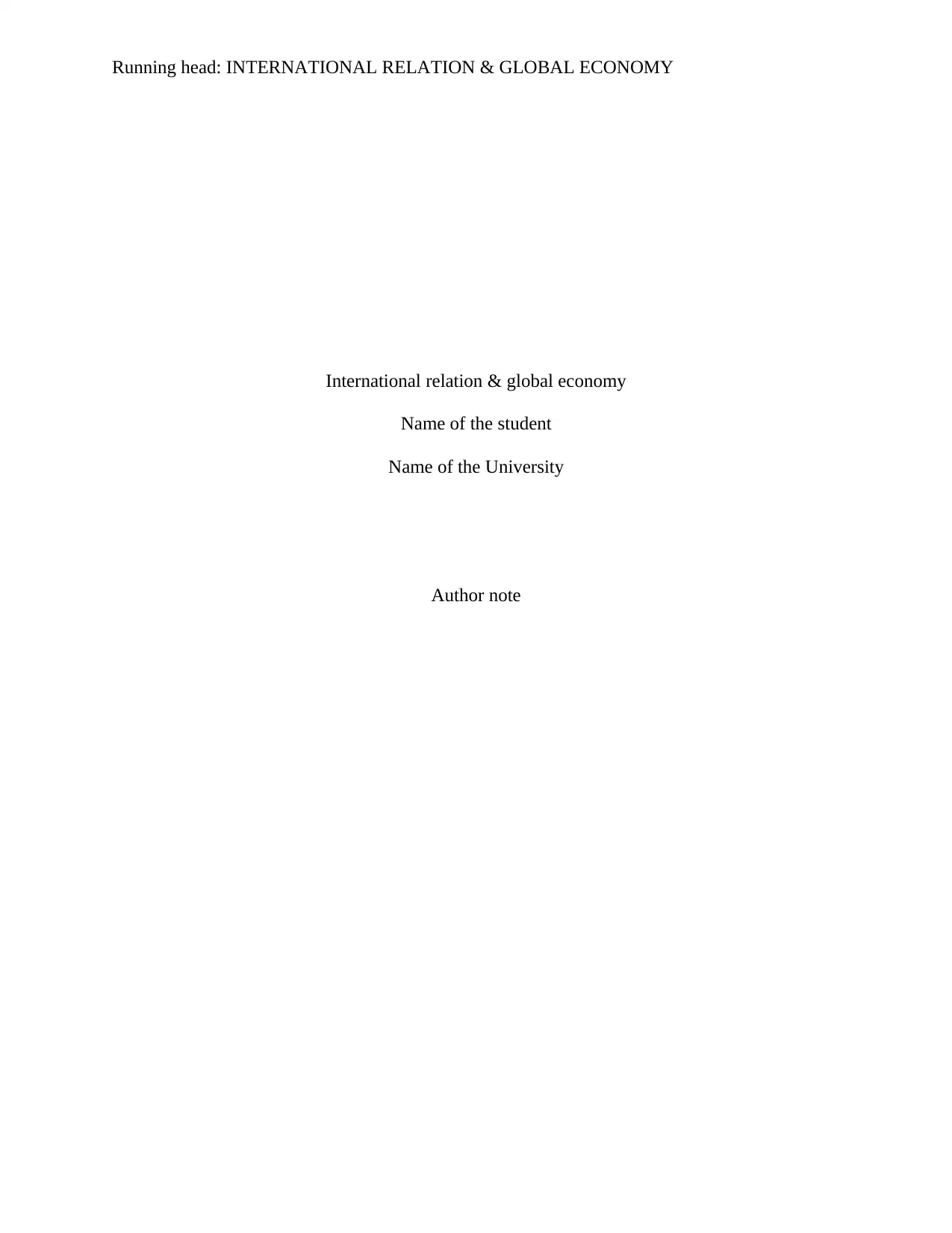
Running head: INTERNATIONAL RELATION & GLOBAL ECONOMY
International relation & global economy
Name of the student
Name of the University
Author note
International relation & global economy
Name of the student
Name of the University
Author note
Paraphrase This Document
Need a fresh take? Get an instant paraphrase of this document with our AI Paraphraser
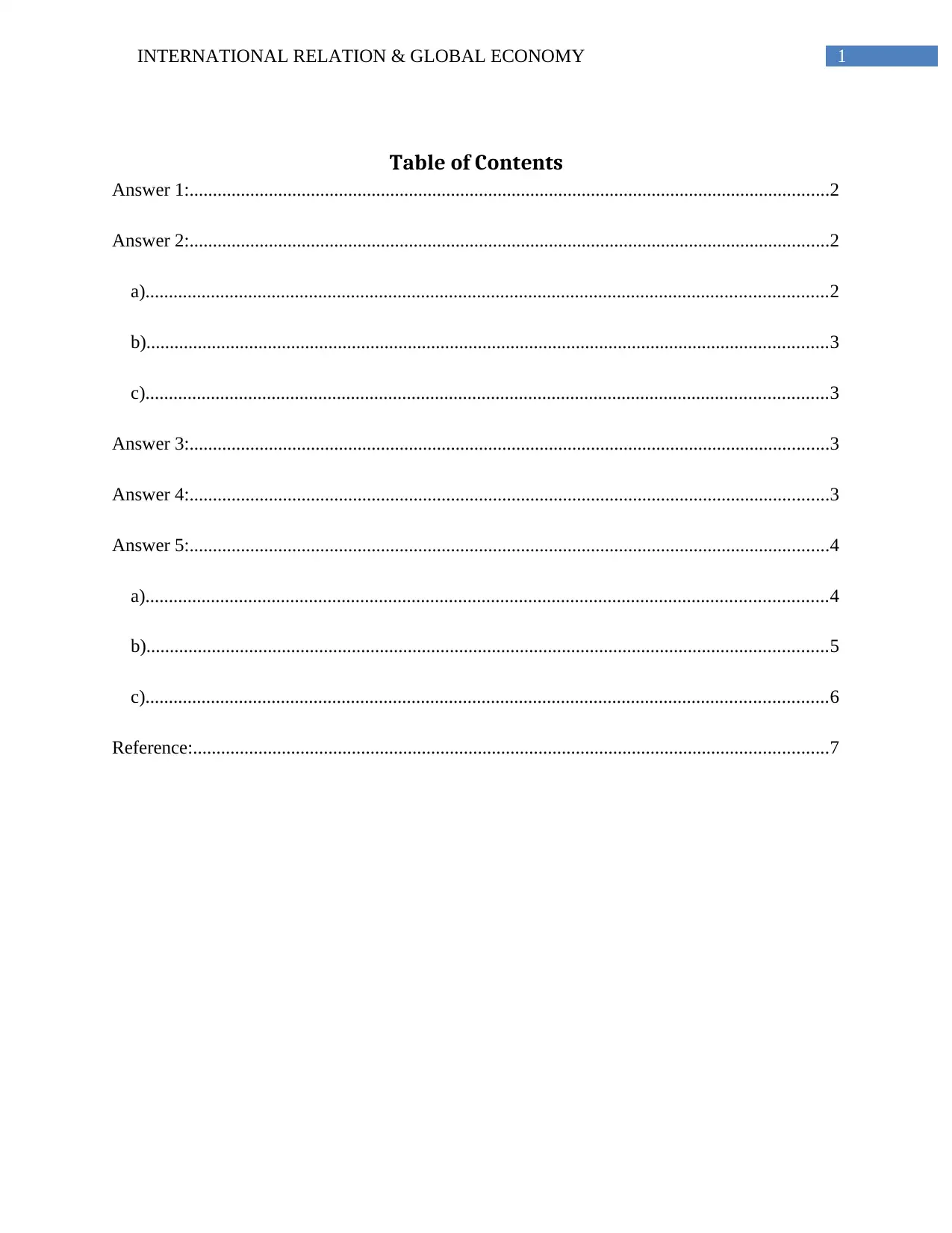
1INTERNATIONAL RELATION & GLOBAL ECONOMY
Table of Contents
Answer 1:.........................................................................................................................................2
Answer 2:.........................................................................................................................................2
a)..................................................................................................................................................2
b)..................................................................................................................................................3
c)..................................................................................................................................................3
Answer 3:.........................................................................................................................................3
Answer 4:.........................................................................................................................................3
Answer 5:.........................................................................................................................................4
a)..................................................................................................................................................4
b)..................................................................................................................................................5
c)..................................................................................................................................................6
Reference:........................................................................................................................................7
Table of Contents
Answer 1:.........................................................................................................................................2
Answer 2:.........................................................................................................................................2
a)..................................................................................................................................................2
b)..................................................................................................................................................3
c)..................................................................................................................................................3
Answer 3:.........................................................................................................................................3
Answer 4:.........................................................................................................................................3
Answer 5:.........................................................................................................................................4
a)..................................................................................................................................................4
b)..................................................................................................................................................5
c)..................................................................................................................................................6
Reference:........................................................................................................................................7
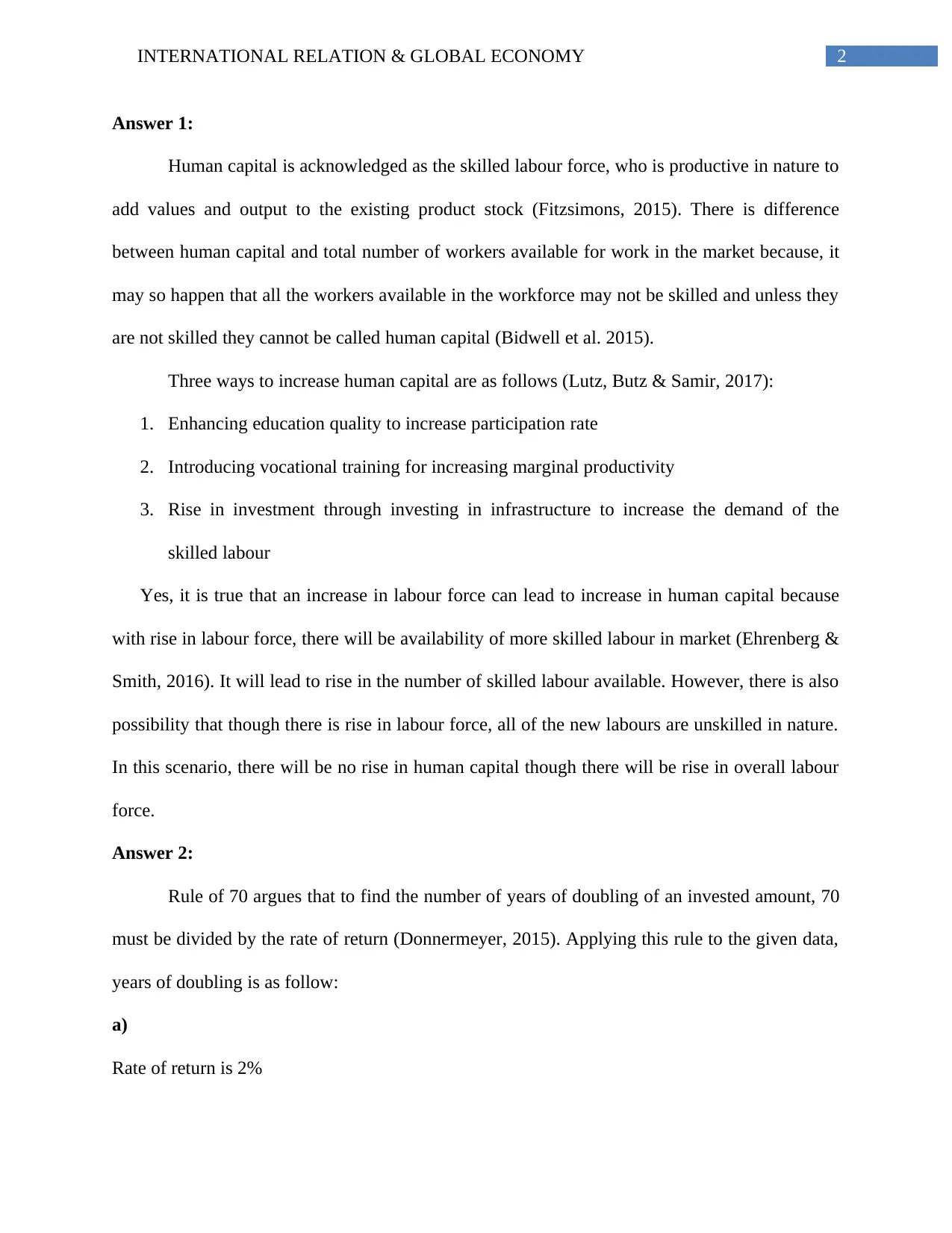
2INTERNATIONAL RELATION & GLOBAL ECONOMY
Answer 1:
Human capital is acknowledged as the skilled labour force, who is productive in nature to
add values and output to the existing product stock (Fitzsimons, 2015). There is difference
between human capital and total number of workers available for work in the market because, it
may so happen that all the workers available in the workforce may not be skilled and unless they
are not skilled they cannot be called human capital (Bidwell et al. 2015).
Three ways to increase human capital are as follows (Lutz, Butz & Samir, 2017):
1. Enhancing education quality to increase participation rate
2. Introducing vocational training for increasing marginal productivity
3. Rise in investment through investing in infrastructure to increase the demand of the
skilled labour
Yes, it is true that an increase in labour force can lead to increase in human capital because
with rise in labour force, there will be availability of more skilled labour in market (Ehrenberg &
Smith, 2016). It will lead to rise in the number of skilled labour available. However, there is also
possibility that though there is rise in labour force, all of the new labours are unskilled in nature.
In this scenario, there will be no rise in human capital though there will be rise in overall labour
force.
Answer 2:
Rule of 70 argues that to find the number of years of doubling of an invested amount, 70
must be divided by the rate of return (Donnermeyer, 2015). Applying this rule to the given data,
years of doubling is as follow:
a)
Rate of return is 2%
Answer 1:
Human capital is acknowledged as the skilled labour force, who is productive in nature to
add values and output to the existing product stock (Fitzsimons, 2015). There is difference
between human capital and total number of workers available for work in the market because, it
may so happen that all the workers available in the workforce may not be skilled and unless they
are not skilled they cannot be called human capital (Bidwell et al. 2015).
Three ways to increase human capital are as follows (Lutz, Butz & Samir, 2017):
1. Enhancing education quality to increase participation rate
2. Introducing vocational training for increasing marginal productivity
3. Rise in investment through investing in infrastructure to increase the demand of the
skilled labour
Yes, it is true that an increase in labour force can lead to increase in human capital because
with rise in labour force, there will be availability of more skilled labour in market (Ehrenberg &
Smith, 2016). It will lead to rise in the number of skilled labour available. However, there is also
possibility that though there is rise in labour force, all of the new labours are unskilled in nature.
In this scenario, there will be no rise in human capital though there will be rise in overall labour
force.
Answer 2:
Rule of 70 argues that to find the number of years of doubling of an invested amount, 70
must be divided by the rate of return (Donnermeyer, 2015). Applying this rule to the given data,
years of doubling is as follow:
a)
Rate of return is 2%
⊘ This is a preview!⊘
Do you want full access?
Subscribe today to unlock all pages.

Trusted by 1+ million students worldwide
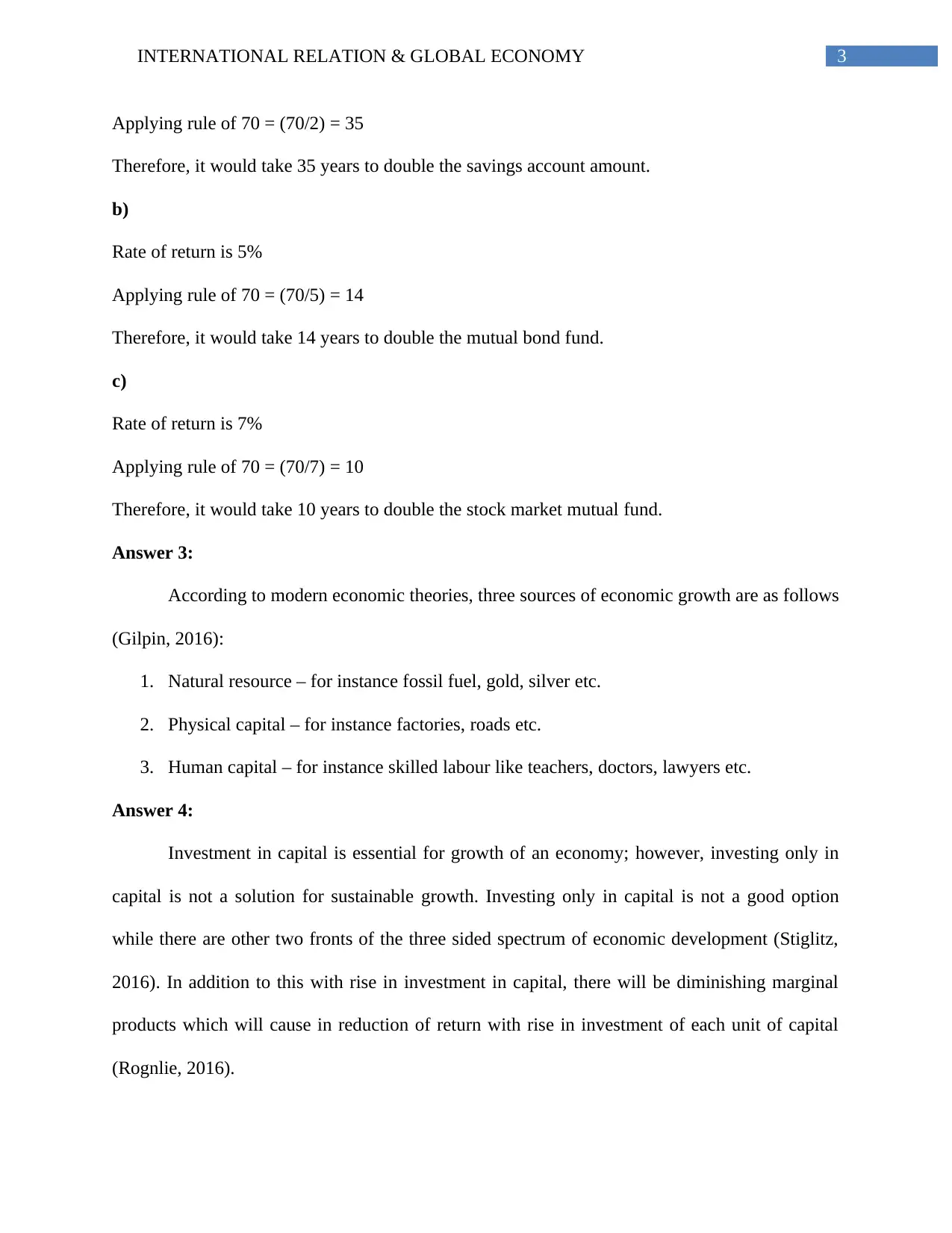
3INTERNATIONAL RELATION & GLOBAL ECONOMY
Applying rule of 70 = (70/2) = 35
Therefore, it would take 35 years to double the savings account amount.
b)
Rate of return is 5%
Applying rule of 70 = (70/5) = 14
Therefore, it would take 14 years to double the mutual bond fund.
c)
Rate of return is 7%
Applying rule of 70 = (70/7) = 10
Therefore, it would take 10 years to double the stock market mutual fund.
Answer 3:
According to modern economic theories, three sources of economic growth are as follows
(Gilpin, 2016):
1. Natural resource – for instance fossil fuel, gold, silver etc.
2. Physical capital – for instance factories, roads etc.
3. Human capital – for instance skilled labour like teachers, doctors, lawyers etc.
Answer 4:
Investment in capital is essential for growth of an economy; however, investing only in
capital is not a solution for sustainable growth. Investing only in capital is not a good option
while there are other two fronts of the three sided spectrum of economic development (Stiglitz,
2016). In addition to this with rise in investment in capital, there will be diminishing marginal
products which will cause in reduction of return with rise in investment of each unit of capital
(Rognlie, 2016).
Applying rule of 70 = (70/2) = 35
Therefore, it would take 35 years to double the savings account amount.
b)
Rate of return is 5%
Applying rule of 70 = (70/5) = 14
Therefore, it would take 14 years to double the mutual bond fund.
c)
Rate of return is 7%
Applying rule of 70 = (70/7) = 10
Therefore, it would take 10 years to double the stock market mutual fund.
Answer 3:
According to modern economic theories, three sources of economic growth are as follows
(Gilpin, 2016):
1. Natural resource – for instance fossil fuel, gold, silver etc.
2. Physical capital – for instance factories, roads etc.
3. Human capital – for instance skilled labour like teachers, doctors, lawyers etc.
Answer 4:
Investment in capital is essential for growth of an economy; however, investing only in
capital is not a solution for sustainable growth. Investing only in capital is not a good option
while there are other two fronts of the three sided spectrum of economic development (Stiglitz,
2016). In addition to this with rise in investment in capital, there will be diminishing marginal
products which will cause in reduction of return with rise in investment of each unit of capital
(Rognlie, 2016).
Paraphrase This Document
Need a fresh take? Get an instant paraphrase of this document with our AI Paraphraser
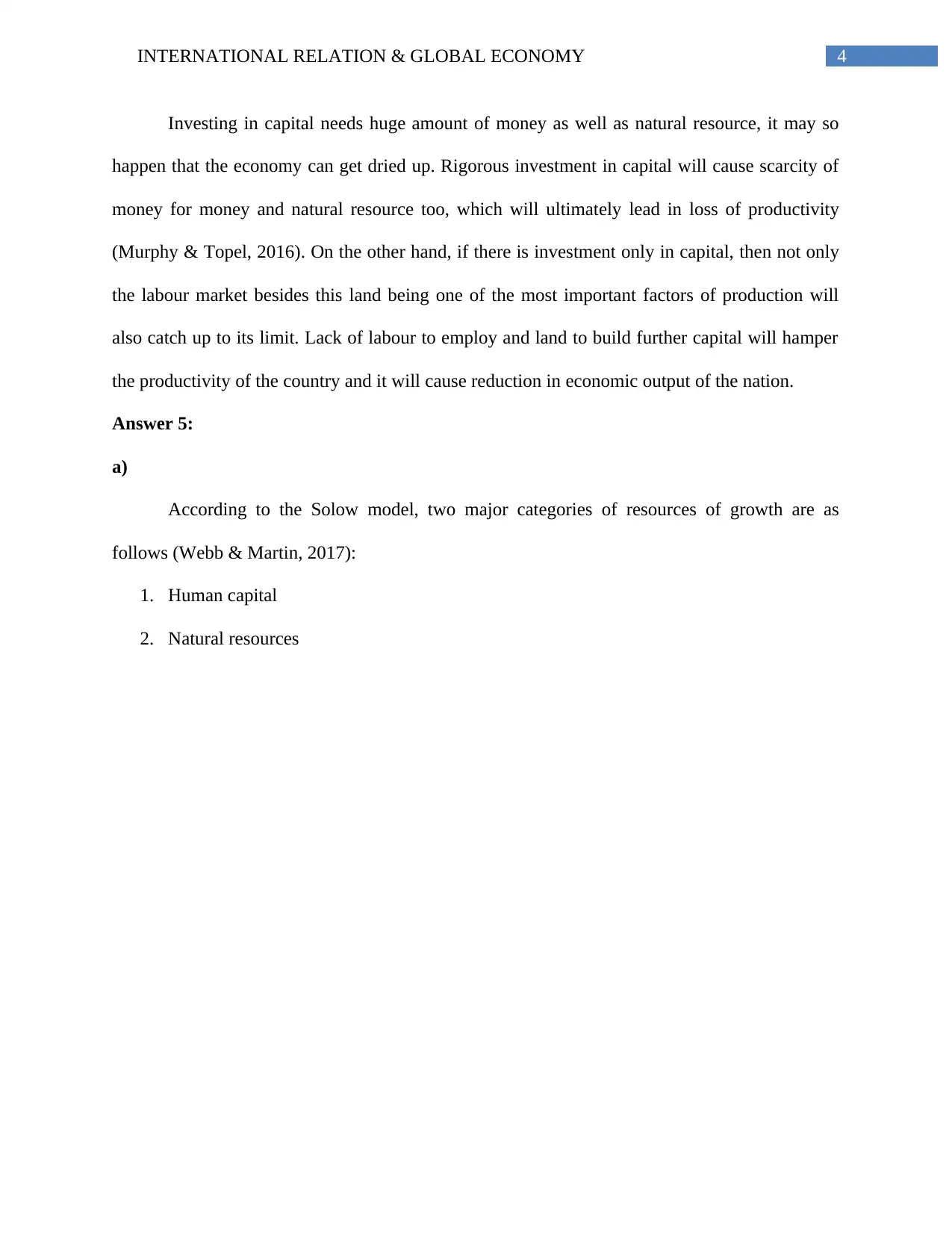
4INTERNATIONAL RELATION & GLOBAL ECONOMY
Investing in capital needs huge amount of money as well as natural resource, it may so
happen that the economy can get dried up. Rigorous investment in capital will cause scarcity of
money for money and natural resource too, which will ultimately lead in loss of productivity
(Murphy & Topel, 2016). On the other hand, if there is investment only in capital, then not only
the labour market besides this land being one of the most important factors of production will
also catch up to its limit. Lack of labour to employ and land to build further capital will hamper
the productivity of the country and it will cause reduction in economic output of the nation.
Answer 5:
a)
According to the Solow model, two major categories of resources of growth are as
follows (Webb & Martin, 2017):
1. Human capital
2. Natural resources
Investing in capital needs huge amount of money as well as natural resource, it may so
happen that the economy can get dried up. Rigorous investment in capital will cause scarcity of
money for money and natural resource too, which will ultimately lead in loss of productivity
(Murphy & Topel, 2016). On the other hand, if there is investment only in capital, then not only
the labour market besides this land being one of the most important factors of production will
also catch up to its limit. Lack of labour to employ and land to build further capital will hamper
the productivity of the country and it will cause reduction in economic output of the nation.
Answer 5:
a)
According to the Solow model, two major categories of resources of growth are as
follows (Webb & Martin, 2017):
1. Human capital
2. Natural resources
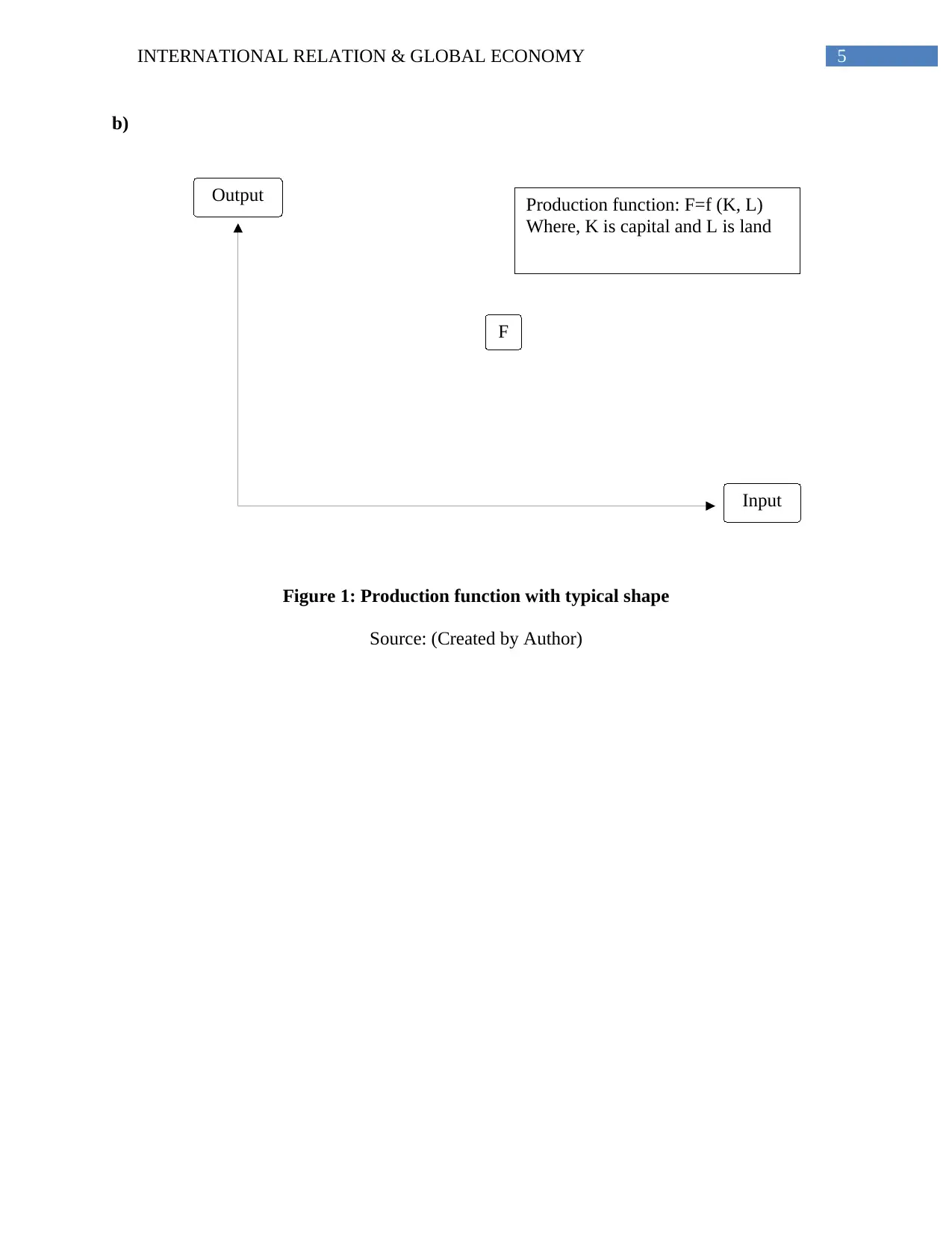
5INTERNATIONAL RELATION & GLOBAL ECONOMY
F
Output
Input
Production function: F=f (K, L)
Where, K is capital and L is land
b)
Figure 1: Production function with typical shape
Source: (Created by Author)
F
Output
Input
Production function: F=f (K, L)
Where, K is capital and L is land
b)
Figure 1: Production function with typical shape
Source: (Created by Author)
⊘ This is a preview!⊘
Do you want full access?
Subscribe today to unlock all pages.

Trusted by 1+ million students worldwide
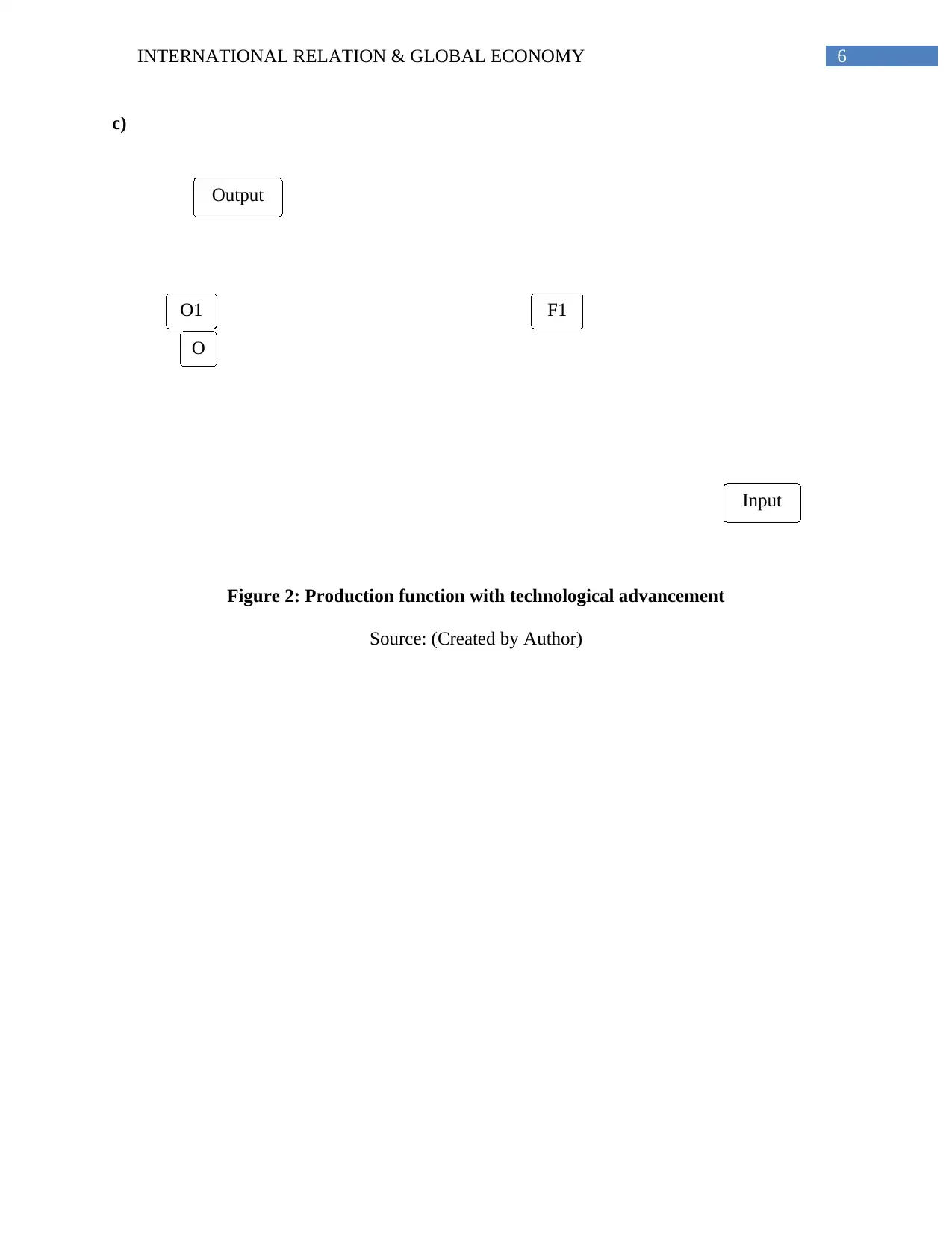
6INTERNATIONAL RELATION & GLOBAL ECONOMY
F1
Output
Input
O
O1
c)
Figure 2: Production function with technological advancement
Source: (Created by Author)
F1
Output
Input
O
O1
c)
Figure 2: Production function with technological advancement
Source: (Created by Author)
Paraphrase This Document
Need a fresh take? Get an instant paraphrase of this document with our AI Paraphraser
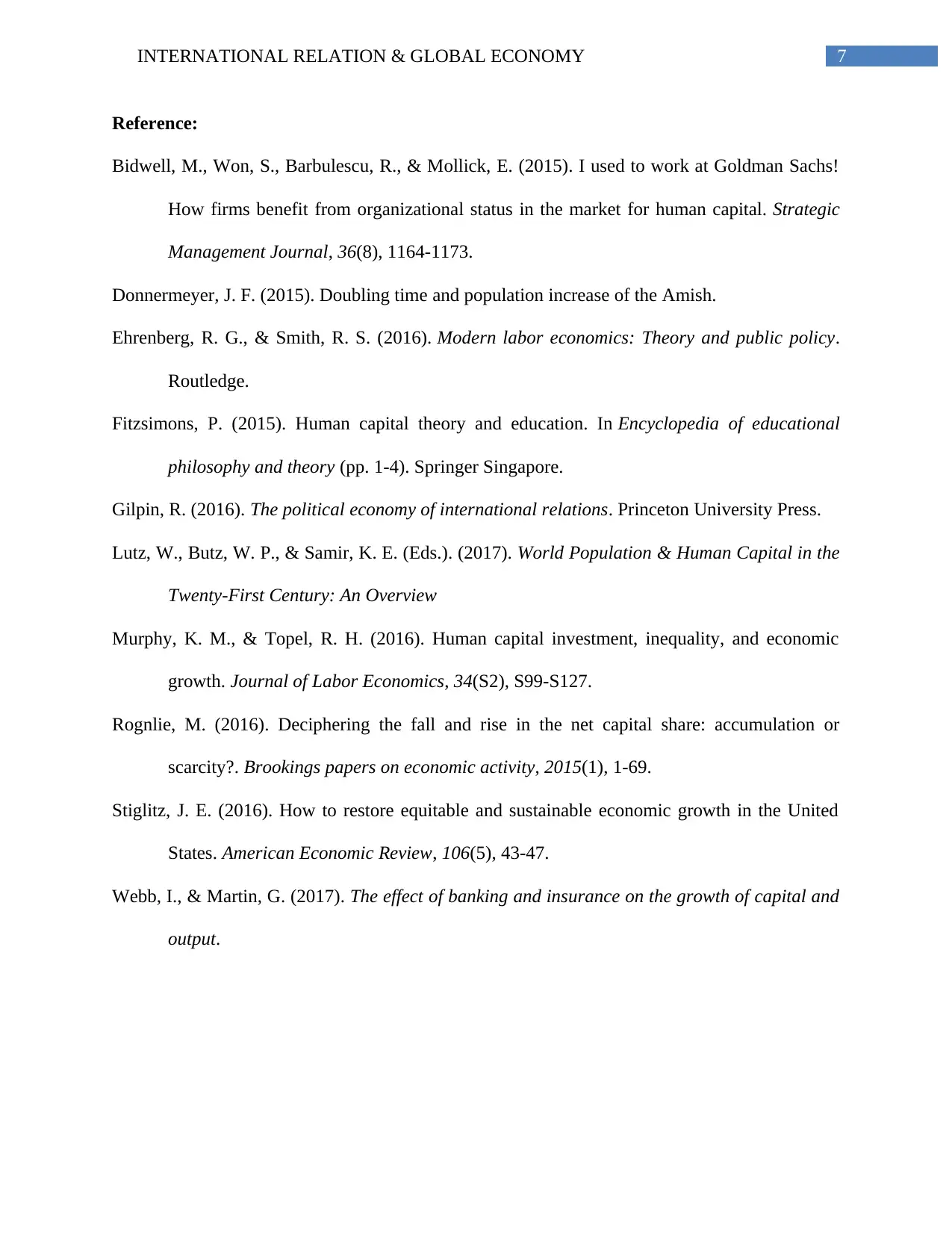
7INTERNATIONAL RELATION & GLOBAL ECONOMY
Reference:
Bidwell, M., Won, S., Barbulescu, R., & Mollick, E. (2015). I used to work at Goldman Sachs!
How firms benefit from organizational status in the market for human capital. Strategic
Management Journal, 36(8), 1164-1173.
Donnermeyer, J. F. (2015). Doubling time and population increase of the Amish.
Ehrenberg, R. G., & Smith, R. S. (2016). Modern labor economics: Theory and public policy.
Routledge.
Fitzsimons, P. (2015). Human capital theory and education. In Encyclopedia of educational
philosophy and theory (pp. 1-4). Springer Singapore.
Gilpin, R. (2016). The political economy of international relations. Princeton University Press.
Lutz, W., Butz, W. P., & Samir, K. E. (Eds.). (2017). World Population & Human Capital in the
Twenty-First Century: An Overview
Murphy, K. M., & Topel, R. H. (2016). Human capital investment, inequality, and economic
growth. Journal of Labor Economics, 34(S2), S99-S127.
Rognlie, M. (2016). Deciphering the fall and rise in the net capital share: accumulation or
scarcity?. Brookings papers on economic activity, 2015(1), 1-69.
Stiglitz, J. E. (2016). How to restore equitable and sustainable economic growth in the United
States. American Economic Review, 106(5), 43-47.
Webb, I., & Martin, G. (2017). The effect of banking and insurance on the growth of capital and
output.
Reference:
Bidwell, M., Won, S., Barbulescu, R., & Mollick, E. (2015). I used to work at Goldman Sachs!
How firms benefit from organizational status in the market for human capital. Strategic
Management Journal, 36(8), 1164-1173.
Donnermeyer, J. F. (2015). Doubling time and population increase of the Amish.
Ehrenberg, R. G., & Smith, R. S. (2016). Modern labor economics: Theory and public policy.
Routledge.
Fitzsimons, P. (2015). Human capital theory and education. In Encyclopedia of educational
philosophy and theory (pp. 1-4). Springer Singapore.
Gilpin, R. (2016). The political economy of international relations. Princeton University Press.
Lutz, W., Butz, W. P., & Samir, K. E. (Eds.). (2017). World Population & Human Capital in the
Twenty-First Century: An Overview
Murphy, K. M., & Topel, R. H. (2016). Human capital investment, inequality, and economic
growth. Journal of Labor Economics, 34(S2), S99-S127.
Rognlie, M. (2016). Deciphering the fall and rise in the net capital share: accumulation or
scarcity?. Brookings papers on economic activity, 2015(1), 1-69.
Stiglitz, J. E. (2016). How to restore equitable and sustainable economic growth in the United
States. American Economic Review, 106(5), 43-47.
Webb, I., & Martin, G. (2017). The effect of banking and insurance on the growth of capital and
output.
1 out of 8
Related Documents
Your All-in-One AI-Powered Toolkit for Academic Success.
+13062052269
info@desklib.com
Available 24*7 on WhatsApp / Email
![[object Object]](/_next/static/media/star-bottom.7253800d.svg)
Unlock your academic potential
Copyright © 2020–2025 A2Z Services. All Rights Reserved. Developed and managed by ZUCOL.





